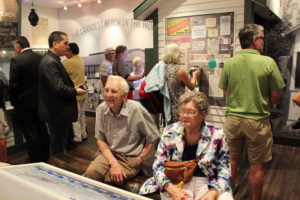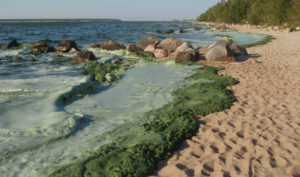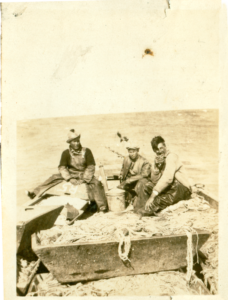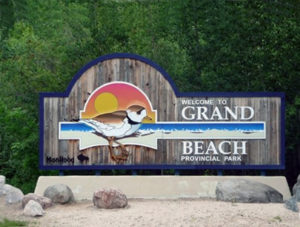
Have you visited East Beaches Heritage Wing, one of the RM of St. Clements best-kept-secrets, yet?
As of mid summer 2017, over 7800 people from all over the world have visited this award-winning museum since it first opened in 2015. In 2015, the exhibit Putting Food on the Table received an Honourable Mention under Interpretation Canada’s Awards of Excellence. The East Beaches Heritage Wing exhibit won the 2016 Award of Excellence from the Association of Manitoba Museums
Find out what’s new in the latest edition of the East Beaches Heritage Wing newsletter. Download East Beaches Heritage Wing Newsletter June 2017 here.
Admission
Free admission
Donations welcome
Location
Grand Marais Community Central
36058 PTH 12
Grand Marais, Manitoba, Canada R0E 0T0
Phone: 204-754-3596
Off-season phone: 204-482-3300 (RM of St. Clements Municipal Office)
Hours
| May and June | ||||||
| Sunday | Monday | Tuesday | Wednesday | Thursday | Friday | Saturday |
| 9:00 am to 9:00 pm | 9:00 am to 5:00 pm | 9:00 am to 5:00 pm | 9:00 am to 5:00 pm | 9:00 am to 5:00 pm | 9:00 am to 9:00 pm | 9:00 am to 9:00 pm |
| July to September long weekend | ||||||
| Sunday | Monday | Tuesday | Wednesday | Thursday | Friday | Saturday |
| 9:00 am to 9:00 pm | 9:00 am to 7:00 pm | 9:00 am to 7:00 pm | 9:00 am to 7:00 pm | 9:00 am to 7:00 pm | 9:00 am to 9:00 pm | 9:00 am to 9:00 pm |
East Beaches Heritage Wing Exhibits
Lake Winnipeg
Learn how Lake Winnipeg and its beautiful beaches came to be. Then explore the lake’s ecology, health threats, and ways to keep it healthy.

- Learn about the mighty Lake Winnipeg’s origins, its watershed and health.
- Two aquariums featuring local flora and fauna let you see firsthand what lives in the deep and the shallows of Lake Winnipeg.
- Explore an interactive digital map of Lake Winnipeg with animation and videos.
- Find out about threats to Lake Winnipeg’s health and what you can do to keep it healthy.
- Grand Beach has been designated Blue Flag status, an international recognition of clean and safe beaches.
Our Roots
First Nations, Métis and European immigrants found ways to survive and sometimes thrive together in their relative isolation on the edge of Lake Winnipeg.
First Nations

- Cree and Ojibwa First Nations have called the eastern shores of Lake Winnipeg home the longest.
- The First Nations lifestyle was tied to the seasons and land. Even after Treaty 1 was signed in 1871 and people settled in nearby Brokenhead and Sagkeeng communities, people continue to rely on the land and lake to provide a living.
Homesteaders
- Métis and later European homesteaders were next to establish homes along the East Beaches.
- Fishing, trapping, harvesting wood, mink farming, mixed farming, hunting and gathering were ways people put food on the table in this rugged and relatively isolated area.
- View artifacts from our community roots: bead work, baskets, treasures brought from the old country.
Storytelling and Photos
- Listen to stories from the old timers as they talk about life at the edge of the lake.
- A digital photo album will reflect the lives of these founding families.
- People were resourceful, independent and self-sufficient but they helped out their neighbours in times of need.
- We are proud of our First Nations, Métis and European roots.
Glory Days
Big changes came when the railway forged its way up to the beaches to build a resort on one of the grandest beaches in the world.
- Life at the beaches changed forever with the coming of the railway in 1916. The East Beaches were no longer isolated.
- See our model railway of Grand Beach with its dance hall, boardwalk, carousel, and hotel. Run the train and hear the sounds of the train, dance hall and carousel.
- Check out the interactive mural of the beach and dance hall from the early days.

Train station at Grand Beach Manitoba - Explore several interactive photo albums: A Day at the Beach, The Family Cabin, Stories from the Beach, and more.
- Peek inside of Harry’s Hideout, a former theatre and dance hot spot, to see a movie trailer and find out who Harry was.
- The influx of so many people changed life for the year-round residents of the area. Servicing tourists — whether selling them fresh fish or berries or building cottages — became a big part of the local economy.
- Use the old style public telephone to call a local about ice delivery or to order fish, berries, firewood, milk and more.
- The end of an era. Changes after World War II affected the area. The building of a road spelled the end of the railway. From 1950 to 1963 the area saw much change: the dance hall burned down (1950), electricity came to the area (1953), the province bought the resort to create a provincial park (1961), the Grand Beach Hotel was torn down (1962) and the rails were removed (1963).
Today and the Future

Grand Marais, with a provincial park replacing the railway resort, has matured into a thriving diverse community, as have many East Beaches communities. What does the future hold?
- The East Beaches have matured into a diverse community that is still strongly connected to the lake.
- Grand Beach is still one of the best known and most visited beach in Manitoba.
- The resort has changed into a favourite provincial park, valued as much for preservation of the unique sand dune ecosystem and surrounding boreal forest as it is for its fabulous four-season recreation opportunities.
- Send a virtual postcard of you at the beach to friends and family.
